Retinoic acid receptor gamma1 (RARgamma1) levels control RARbeta2 expression in SK-N-BE2(c) neuroblastoma cells and regulate a differentiation-apoptosis switch
- PMID: 9774664
- PMCID: PMC109234
- DOI: 10.1128/MCB.18.11.6482
Retinoic acid receptor gamma1 (RARgamma1) levels control RARbeta2 expression in SK-N-BE2(c) neuroblastoma cells and regulate a differentiation-apoptosis switch
Abstract
Vitamin A and its derivatives (retinoids) have profound effects on the proliferation and differentiation of many cell types and are involved in a diverse array of developmental and physiological regulatory processes, including those responsible for the development of the mature nervous system. Retinoid signals are mediated by retinoic acid (RA) receptors (RARs) and retinoid X receptors (RXRs), which show distinct spatio-temporal patterns of expression during development and in adult tissues. We have used SK-N-BE2(c) neuroblastoma cells to study the effects of reciprocal regulation of expression of various RARs. We show that in these cells RARgamma1 acts as a repressor of RARbeta2 transcription in the absence of an agonist. In the presence of RA, the expression of RARgamma1 is reduced and that of RARbeta2 is induced. Overexpression of RARgamma1 neutralizes the effects of RA on RARbeta induction. Expression of an RARgamma1-specific antisense construct leads to the constitutive expression of RARbeta2. Although both overexpression of RARgamma1 and its reduction of expression can result in inhibition of cell proliferation, they induce different morphological changes. Reduction of RARgamma1 (and induction of RARbeta) leads to increased apoptosis, whereas RARgamma1 overexpression leads to differentiation in the absence of apoptosis. Thus, RARgamma1 appears to control a differentiation-apoptosis switch in SK-N-BE2(c) neuroblastoma cells.
Figures

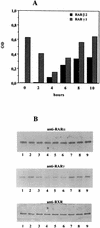
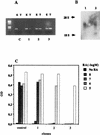


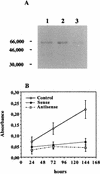

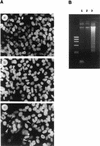
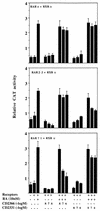


Similar articles
-
Specific activation of retinoic acid receptors (RARs) and retinoid X receptors reveals a unique role for RARgamma in induction of differentiation and apoptosis of S91 melanoma cells.J Biol Chem. 1997 Jul 25;272(30):18990-9. doi: 10.1074/jbc.272.30.18990. J Biol Chem. 1997. PMID: 9228081
-
Inhibition of trans-retinoic acid-resistant human breast cancer cell growth by retinoid X receptor-selective retinoids.Mol Cell Biol. 1997 Nov;17(11):6598-608. doi: 10.1128/MCB.17.11.6598. Mol Cell Biol. 1997. PMID: 9343423 Free PMC article.
-
Effects of novel RAR- and RXR-selective retinoids on myeloid leukemic proliferation and differentiation in vitro.Blood. 1999 Mar 15;93(6):2057-66. Blood. 1999. PMID: 10068679
-
F9 embryocarcinoma cells: a cell autonomous model to study the functional selectivity of RARs and RXRs in retinoid signaling.Histol Histopathol. 2001 Jul;16(3):909-22. doi: 10.14670/HH-16.909. Histol Histopathol. 2001. PMID: 11510982 Review.
-
Retinoid, retinoic acid receptor beta and breast cancer.Breast Cancer Res Treat. 2002 Nov;76(2):167-73. doi: 10.1023/a:1020576606004. Breast Cancer Res Treat. 2002. PMID: 12452454 Review.
Cited by
-
Retinoid pathway and cancer therapeutics.Adv Drug Deliv Rev. 2010 Oct 30;62(13):1285-98. doi: 10.1016/j.addr.2010.07.003. Epub 2010 Aug 3. Adv Drug Deliv Rev. 2010. PMID: 20654663 Free PMC article. Review.
-
Chromosomal integration of retinoic acid response elements prevents cooperative transcriptional activation by retinoic acid receptor and retinoid X receptor.Mol Cell Biol. 2002 Mar;22(5):1446-59. doi: 10.1128/MCB.22.5.1446-1459.2002. Mol Cell Biol. 2002. PMID: 11839811 Free PMC article.
-
Oncogenic RARγ isoforms promote head and neck cancer proliferation through vinexin-β-mediated cell cycle acceleration and autocrine activation of EGFR signal.Int J Biol Sci. 2025 Jan 1;21(1):1-16. doi: 10.7150/ijbs.100351. eCollection 2025. Int J Biol Sci. 2025. PMID: 39744424 Free PMC article.
-
Nutritional factors and progenitor cell differentiation.Genes Nutr. 2007 Oct;2(1):115-8. doi: 10.1007/s12263-007-0032-7. Genes Nutr. 2007. PMID: 18850156 Free PMC article. No abstract available.
-
Tumor-suppressive activity of retinoic acid receptor-beta in cancer.Cancer Lett. 2007 Aug 8;253(1):14-24. doi: 10.1016/j.canlet.2006.11.019. Epub 2006 Dec 22. Cancer Lett. 2007. PMID: 17188427 Free PMC article. Review.
References
-
- Abemayor E, Chang B, Sidell N. Effects of retinoic acid on the in vivo growth of human neuroblastoma cells. Cancer Lett. 1990;55:1–5. - PubMed
-
- Alles A J, Sulik K K. Retinoic acid-induced spina bifida: evidence for a pathogenetic mechanism. Development. 1990;108:73–81. - PubMed
-
- Biedler J L, Helson L, Spengler B A. Morphology and growth, tumorigenicity, and cytogenetics of human neuroblastoma cells in continuous culture. Cancer Res. 1973;33:2643–2652. - PubMed
Publication types
MeSH terms
Substances
Grants and funding
LinkOut - more resources
Full Text Sources
Molecular Biology Databases
